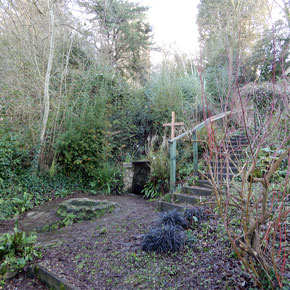Watchet's Heritage - The St. Decuman's Well

St Decuman's Well can easily make claim to being an ancient site and may well have been a place of veneration before Christianity reached our shores.
Whatever your faith or beliefs, you cannot help but be aware of a real sense of spirituality on this most ancient of sites. It is hard not to become a little reflective if you take time to sit here in quiet contemplation, perhaps in the company of a robin whose beautiful song can be heard throughout the year and cannot fail to lift anyone's heart.
As the seasons progress, so does the scene change as the little garden is carefully tended by volunteers and for each season, it will tell a different story. It is, of course, our most ancient spiritual site that dates from a time when any fresh water source or natural spring would be imbued with curative and supernatural properties and in all probability, it existed here before Christianity reached our shores.
It may well have its roots in Pagan Britain and I believe that Pagans visit the site even today. Why do we know it as St Decuman's Well? The name comes from the Welsh saint who gives our beautiful Church its name and of course there is a legend - St. Decuman arrived across the Severn Sea from Wales, rather surprisingly accompanied by a cow on a hurdle. This is cleverly portrayed in a pebble mosaic to the side of the town library. This does make sense as the saint was thus assured of a constant supply of fresh milk. His intention of course was to convert the locals to Christianity and found a Church. Events that followed his arrival are told in numerous lurid accounts, but whichever way you look at it, it is pretty gruesome. His arrival had caused quite a stir, as you might imagine. He was eyed with deep suspicion and one local inhabitant, taking exception to his presence, lopped off his head.
Even with today's advances in medical science, it would suggest that this was curtains, but not a bit of it. The saint, undeterred, calmly picked up his severed head, walked to the well, washed it and replaced it on his head!
Our saint is not unique in respect of losing his head in this manner; in fact, there are a number of such instances throughout the British Isles and they are given the specific name of cephalophores. In pagan practice, the head was particularly significant and the skull of a venerated person on his demise might have the crown adapted as a drinking cup. It was considered that it was imbued with mystic powers that the user might acquire when using it for drinking. A number of examples have been found at the sites of ancient wells.
Incidentally, a full-length depiction of ours is set into a niche on the west front of Wells Cathedral and if you stroll around our Church here, it might be fun to try and locate a more modest depiction set into one of the exterior walls.
For further information about the town as a whole,
please visit the hom page or click
Here
This page is provided by Watchet Conservation Society with the help of Watchet Chamber of Trade
and with funding from Somerset West & Taunton Council's High Street Emergency Fund.
Text and history provided by Nick Cotton
